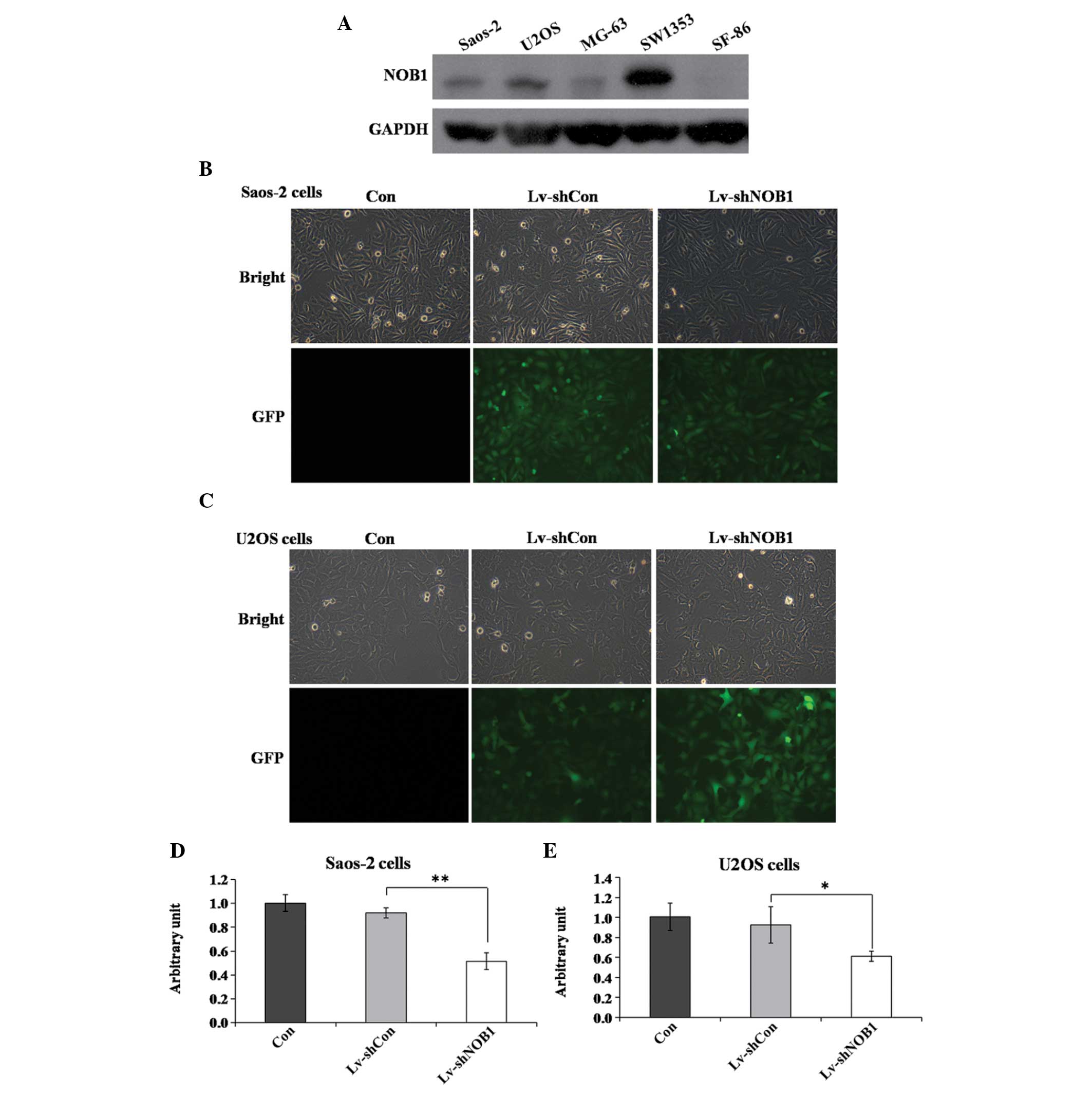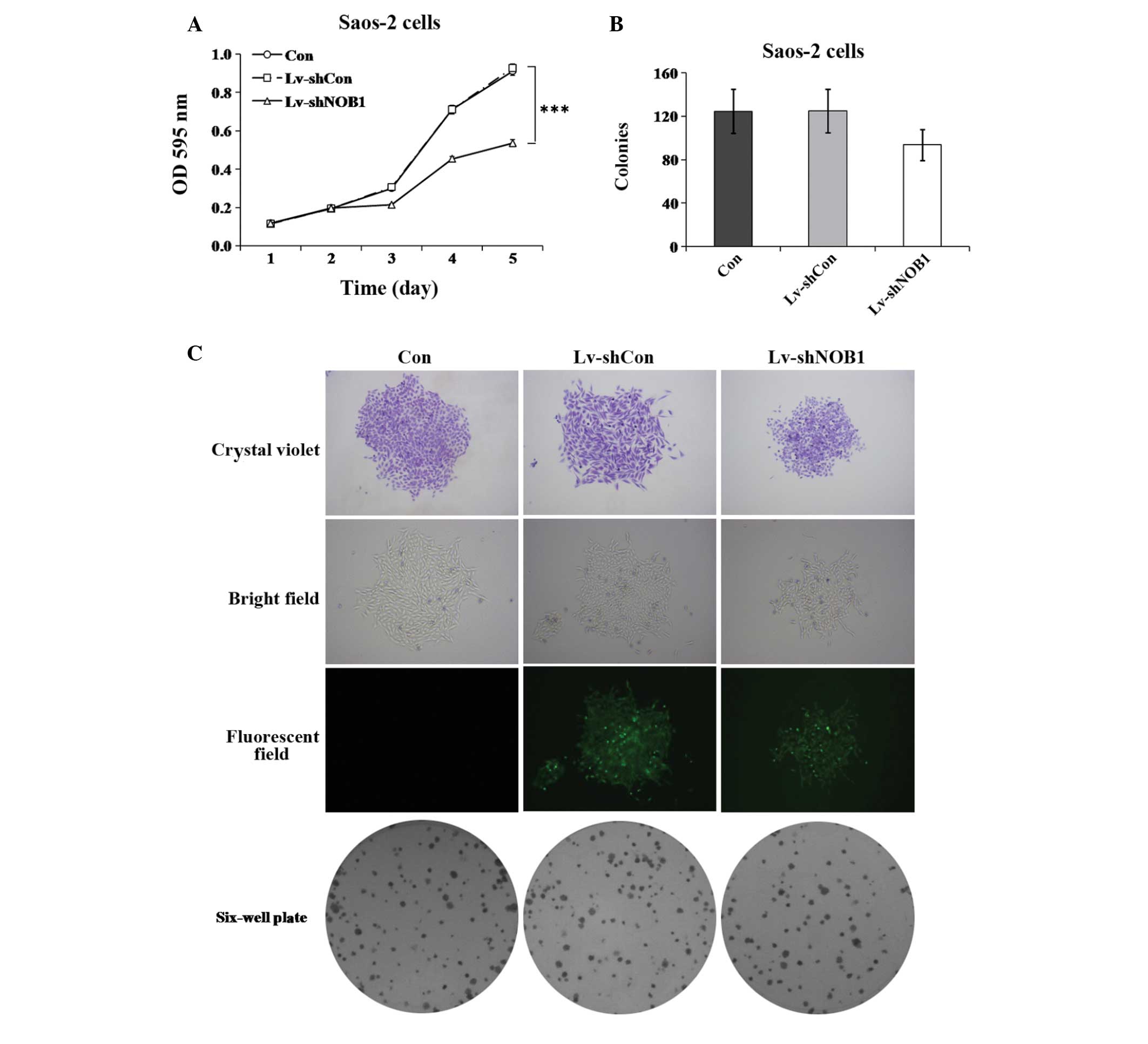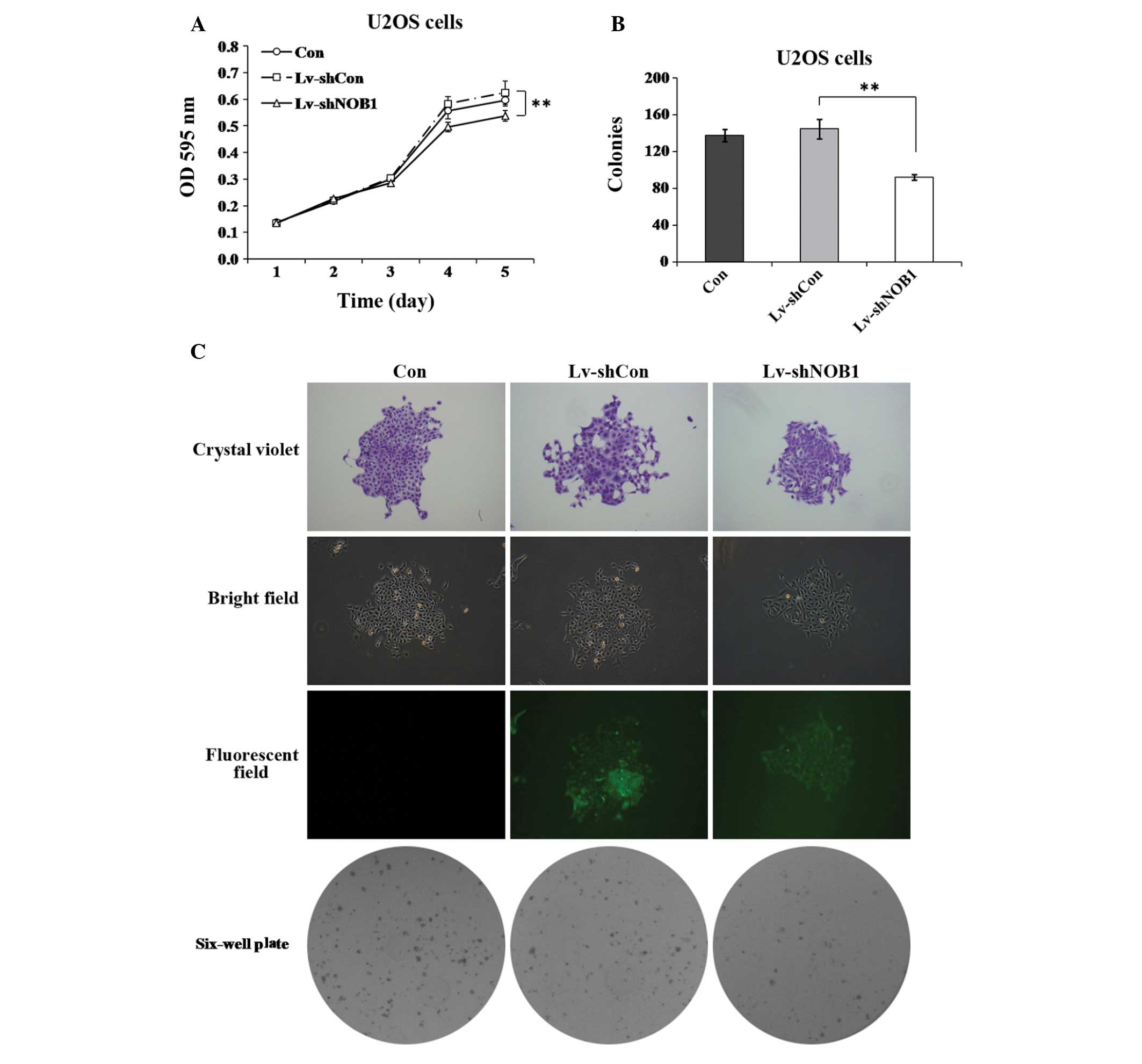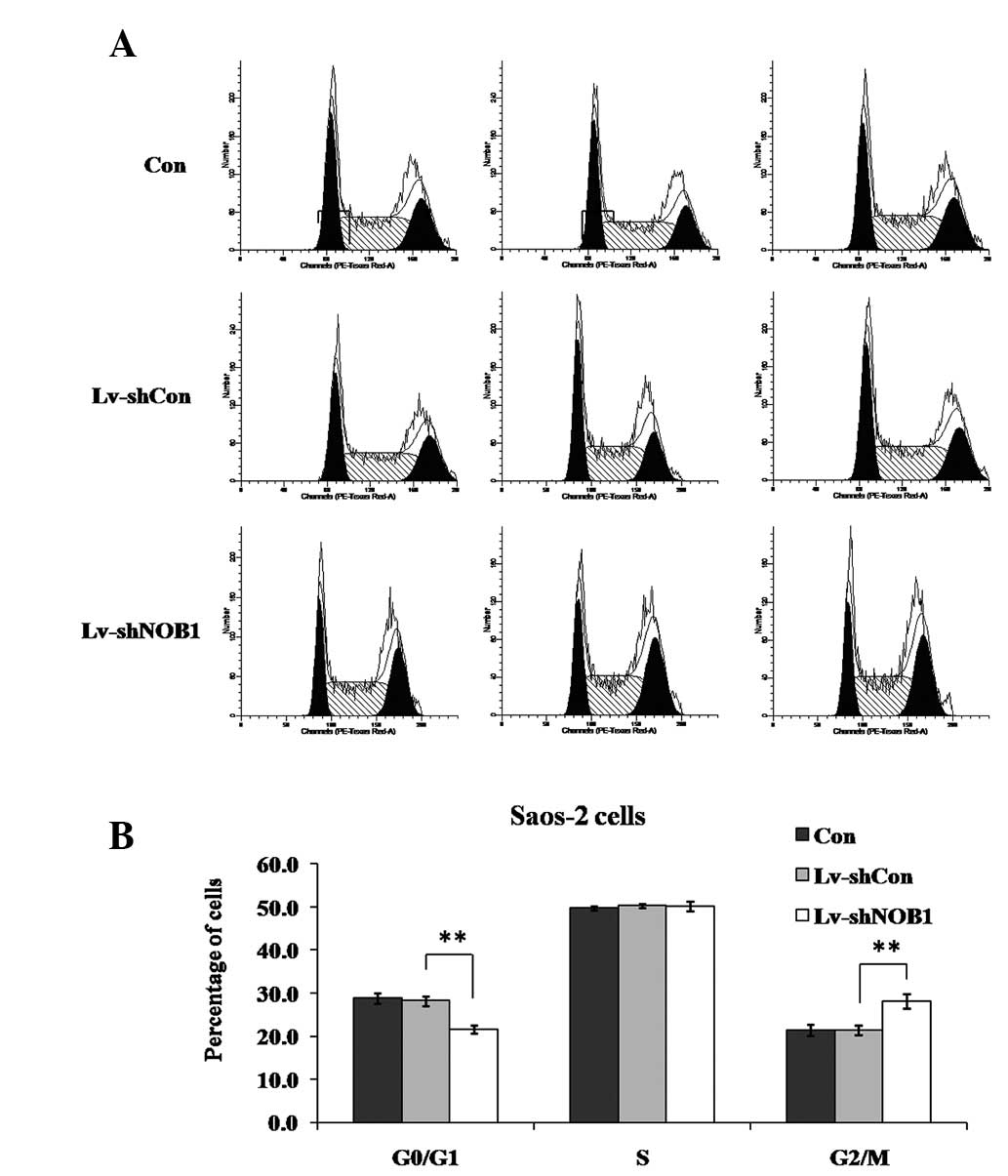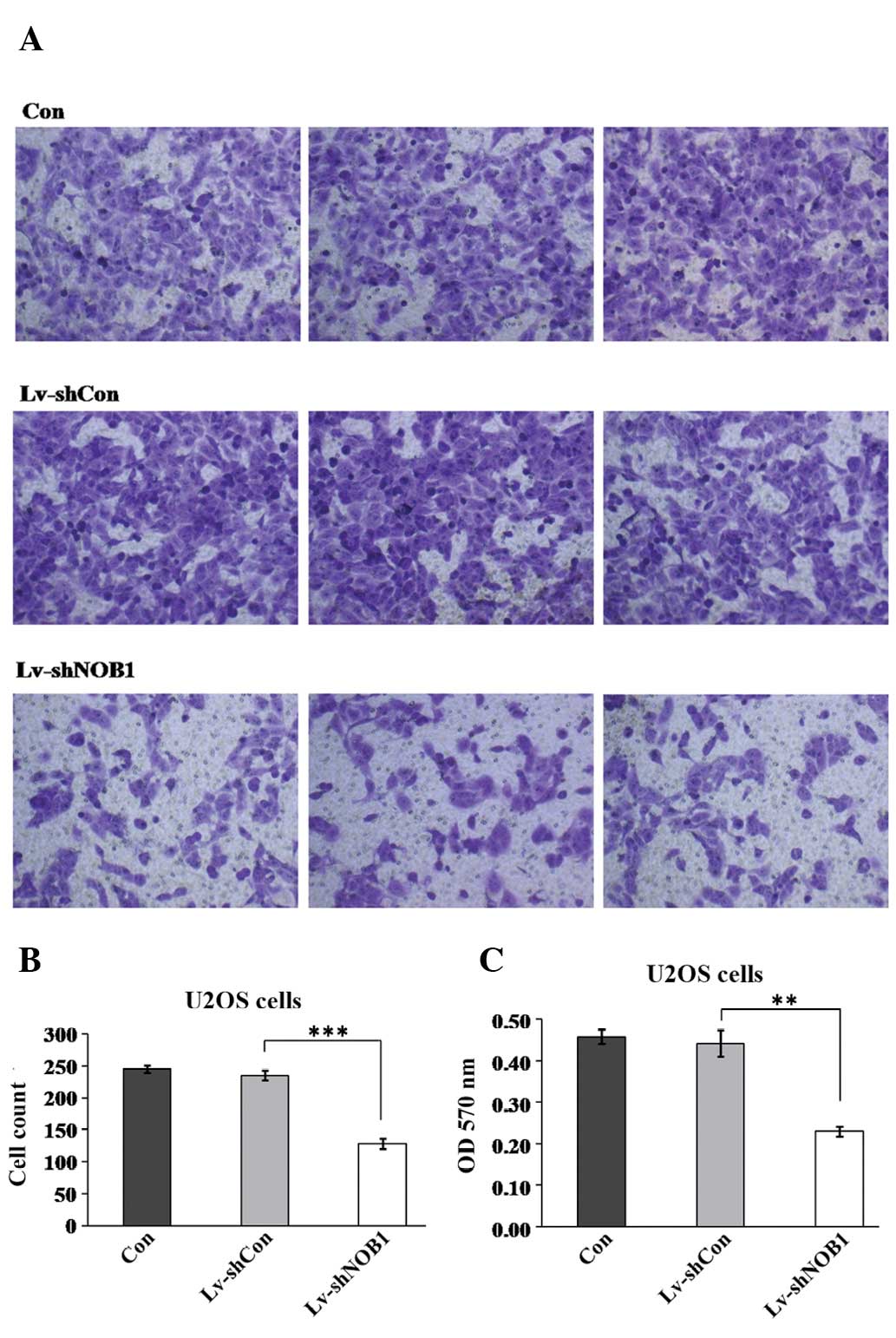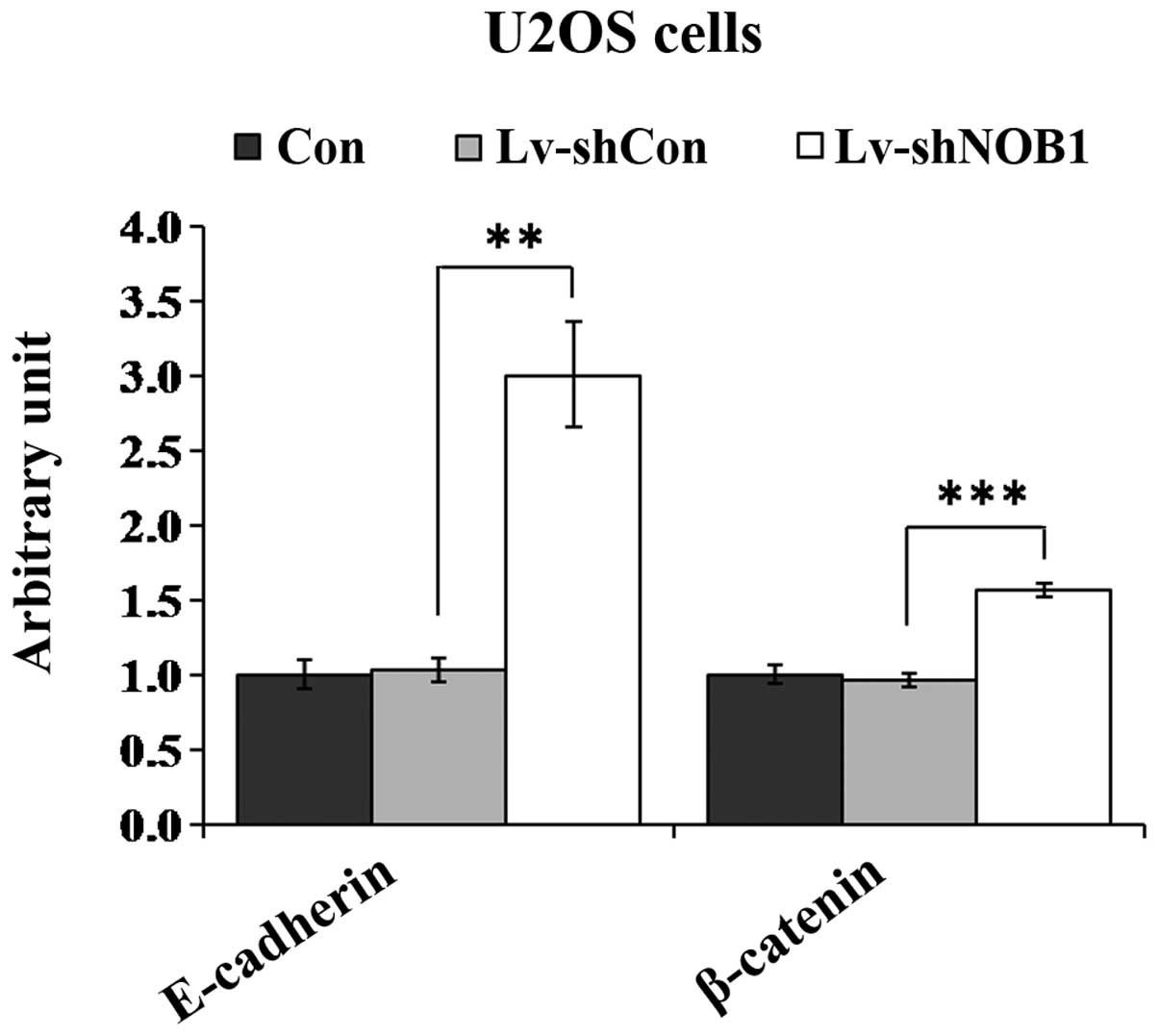Gene silencing of NOB1 by lentivirus suppresses growth and migration of human osteosarcoma cells
Corrigendum in: /10.3892/mmr.2022.12909
- Authors:
- Published online on: April 4, 2014 https://doi.org/10.3892/mmr.2014.2119
- Pages: 2173-2179
-
Copyright: © Chen et al. This is an open access article distributed under the terms of Creative Commons Attribution License [CC BY_NC 3.0].
Abstract
Introduction
In eukaryotic cells, the process of proteolysis is executed by a diverse group of enzymes known as proteases, and the ubiquitin-proteasome pathway (UPP) is the most significant intracellular proteolytic pathway. The degradation process mediated by the UPP involves two steps: i) The target proteins are ubiquitinated by multiple ubiquitin molecules; and ii) the tagged proteins are recognized and degraded by the major ATP-dependent protease, the 26S proteasome complex (1). The 26S proteasome is a biological macromolecule containing a 20S catalytic core and two 19S regulatory complexes (2). Selective degradation of proteins by the UPP is a critical determinant for maintaining cellular homeostasis. Numerous proteasome target proteins are involved in the regulation of cancer cell proliferation, differentiation and apoptosis (3,4). Therefore, the aberrant degradation of oncoproteins or tumor suppressor proteins can result in uncontrolled cell growth in numerous cancer types.
In vitro and in vivo studies have demonstrated that inhibition of proteasomes is an effective anticancer therapeutic approach. Bortezomib, one of the first proteasome inhibitors, which was designed to inhibit the activity of the 26S proteasome by binding to the N-terminal threonine residues at the active site of the catalytic region (5), was shown to be efficient against a variety of malignancies, including myeloma, chronic lymphocytic leukemia and certain solid tumors (6–8). Osteosarcoma is the most common primary bone sarcoma and mostly affects adolescent patients. Since osteosarcoma is metastatic and highly aggressive, novel treatment strategies must be developed. Bortezomib has been shown to suppress growth and induces apoptosis in osteosarcoma cells and xenografts (8). The thiazole antibiotic thiostrepton, which has been identified as a proteasome inhibitor in mammalian tumor cells (9), induces apoptosis in a wide variety of human cancer cell lines, including osteosarcoma cells, on its own or in combination with bortezomib (5,10). These data strongly suggest that proteasome inhibition may also be effective as an adjuvant to current treatment regimens for osteosarcoma.
NIN1/RPN12 binding protein 1 homolog (NOB1), which was firstly identified in Saccharomyces cerevisiae, encodes the essential protein Nin one binding protein (NOB1p) (11). As a chaperone protein, NOB1p joins the 20S proteasome with the 19S regulatory particle in the nucleus and facilitates the maturation of the 20S proteasome, thereby favoring the completion of 26S proteasome biogenesis (12). Furthermore, NOB1, along with five other genes, has been used as a diagnostic marker discriminating chronic phase from blast crisis chronic myelogenous leukemia (13). RNA interference (RNAi)-mediated downregulation of NOB1 suppresses the growth of human ovarian cancer cells and hepatocellular carcinoma cells (14,15). In the present study, short hairpin RNA (shRNA) was employed to knock down NOB1 in osteosarcoma cells, and the effects of NOB1 silencing on cell growth and migration were explored.
Materials and methods
Materials
SF-86, Saos-2, MG63, SW1353 and U2OS human osteosarcoma cells and HEK-293T cells were obtained from the Type Culture Collection of the Chinese Academy of Sciences (Shanghai, China). TRIzol® reagent was purchased from Invitrogen Life Technologies (Carlsbad, CA, USA). The SYBR® Green Real-Time PCR assay kit was obtained from Applied Biosystems, Inc. (Beijing, China). Rabbit anti-NOB1p antibody was purchased from Sigma-Aldrich (St. Louis, MO, USA). Anti-GAPDH antibody and goat anti-mouse immunoglobulin G conjugated with horseradish peroxidase antibody were obtained from Santa Cruz Biotechnology, Inc. (Santa Cruz, CA, USA). Enhanced chemiluminescence reagents were purchased from Amersham Life Science (Arlington Heights, IL, USA).
Cell culture
Cells were grown in Dulbecco’s Modified Eagle’s medium (DMEM; HyClone, Logan, UT, USA) containing 10% fetal bovine serum (FBS; Invitrogen Life Technologies) at 37°C under 5% CO2.
Lentivirus production and lentiviral transduction
shRNA targeting the NOB1 (CCGGGCTGAACAATTTCAGTCATT TCTCGAGAAATGACTGAAATTGTTCAGCTTTTTG) and negative control (TTCTCCGAACGTGTCACGT) sequences were cloned into pFH-L (Shanghai Hollybio, Shanghai, China). The reconstructed pFH-L-shNOB1 and pFH-L-shCon vectors were then co-transfected into HEK-293T cells together with the helper plasmids pVSVG-I and pCMVΔR8.92 (Shanghai Hollybio) to generate lentiviruses. After 96 h of incubation, the lentiviral particles were harvested from the supernatant by ultracentrifugation (16,17). The RNAi lentiviruses were referred to as shNOB1 for the specific interference with the NOB1 gene and shCon for the negative control. For lentiviral transduction, 40% confluent Saos-2/U2OS osteosarcoma cells were incubated with Lv-shNOB1 or Lv-shCon for 96 h, with a replacement of the media 24 h after lentiviral treatment.
Quantitative polymerase chain reaction (qPCR)
Saos-2 and U2OS cells were cultured in six-well plates and then infected with the shNOB1 or shCon lentiviruses. After 96 h of incubation, total RNA was isolated from cultured cells using TRIzol® reagent and then cDNA was synthesized from total RNA. Two sets of primers were used for PCR: β-actin (ACTB) forward, 5′-GTGGACATCCGCAAAGAC-3′ and reverse, 5′-AAAGGGTGTAACGCAACTA-3′; NOB1 forward, 5′-GAAAGAACAACGCCCTGGAG-3′ and reverse, 5′-CAGCCTTGAGATGACCTAAGC-3′. qPCR was performed according to the manufacturer’s instructions (Applied Biosystems, Inc.). The relative mRNA expression of NOB1 was calculated using the 2−ΔΔCt method (18).
Western blot analysis
Whole cell extracts were prepared with ice-cold cell lysis buffer (10 mM Tris-HCl, pH 7.4, 1 mM EDTA, 0.1% Triton X-100 and 0.1% SDS) and the protein concentration was determined using a Bradford assay kit (Pierce Biotechnology, Inc., Rockford, IL, USA). Protein extracts were separated using SDS-PAGE, transferred onto a nitrocellulose membrane and incubated with anti-NOB1p and anti-GAPDH antibodies. Immunodetection was performed using an enhanced chemiluminescence western blotting kit (Amersham Biosciences Inc., Piscataway, NJ, USA).
Cell proliferation assay
Cells collected from the three groups (Lv-shNOB1, Lv-shCon and control) were trypsinized, resuspended, seeded into 96-well plates at a density of 2,000 cells per well and then incubated at 37°C for 96 h after lentiviral treatment. The number of viable cells was assessed at indicated time-points, when 20 μl MTT solution (5 mg/ml) was added into each well. The plate was incubated for 4 h. The fixed plate was then washed and 100 μl dimethyl sulfoxide was added. The absorbance of each plate was measured at 595 nm using a spectrophotometer.
Colony formation assay
Following infection, cells in the three groups (Lv-shNOB1, Lv-shCon and control) were seeded into a six-well plate at a density of 300 cells per well and maintained at 37°C for 13 or 14 days (U2OS2 and Saos-2 cell lines, respectively). The culture media were changed every 2–3 days. When the colonies were formed, the plate was washed and fixed, stained with Giemsa (Sigma Chemical Co.) for 10 min, and washed three times with double-distilled H2O. The stained cells and colonies (>50 cells/colony) were photographed and counted.
Cell cycle analysis
The cell cycle distribution (G0/G1, S or G2/M phase) was characterized by differences in DNA content via flow cytometry. Cells were collected by centrifugation at 404 × g for 5 min, washed with phosphate-buffered saline (PBS) and fixed in ethanol. The fixed cells were then resuspended in propidium iodide/RNase/PBS for incubation in the dark (37°C, 30 min). The stained cells were analyzed using the FACSCalibur™ II sorter and the CellQuest™ fluorescence-activated cell sorting system (BD Biosciences, San Diego, CA, USA). The percentage of cells in each cell cycle phase was analyzed. Each experiment was repeated three times and the results are shown as the average.
Cell migration assay
The motility and migration of U2OS cells were evaluated using the Transwell assay. Briefly, trypsinized U2OS cells were transferred into the upper chambers of the Transwell plates (8.0-μm pores, Corning Costar, Cambridge, MA, USA). The lower chamber was filled with 500 ml DMEM supplemented with 10% FBS. After 24 h at 37°C under 5% CO2/95% air, cell migration was determined by counting cells in the bottom of the membrane stained with crystal violet, and scored visually in five random fields using light microscopy (magnification, ×100). In addition, migrating cells were dissolved and quantified at 570 nm using a spectrophotometer.
Statistical analysis
Data are expressed as the mean ± standard deviation of at least three independent experiments. Statistical significance was assessed using the Student’s t-test. P<0.05 was considered to indicate a statistically significant difference.
Results
Knockdown of NOB1 by the shRNA lentivirus system in osteosarcoma cells
Expression levels of NOB1p in several osteosarcoma cell lines were assessed using western blot analysis. NOB1p was moderately expressed in Saos-2 and U2OS cells (Fig. 1A). A lentivirus-mediated RNAi system was applied to specifically downregulate the expression of NOB1. To ensure the lentiviral infection efficiency, the expression of green fluorescent protein was detected using fluorescence microscopy. Fig. 1B and C show that, after 96 h of incubation, infection in Saos-2 and U2OS cells was highly efficient (>80%). Knockdown efficiency was determined using qPCR, which showed that the relative levels of NOB1 mRNA transcripts were significantly decreased by almost 50% in the Lv-shNOB1 group as compared with those in the Lv-shCon and Con groups in the two cell lines (Fig. 1D and E). These results demonstrated that endogenous NOB1 expression was specifically inhibited by the Lv-shNOB1 construct.
Effect of NOB1 silencing on proliferation in human osteosarcoma cells
To further investigate the role of NOB1 in regulating the proliferation of osteosarcoma cells, the MTT assay and colony formation analysis were used. As shown in Fig. 2A, the proliferation of Lv-shNOB1-treated Saos-2 cells at 96 h post-infection was markedly inhibited as compared with that in the Lv-shCon and Con groups (P<0.001). As shown in Fig. 2B and C, the colony formation ability of Saos-2 cells was also slightly reduced by NOB1 inhibition (Lv-shNOB1, 94±14 colonies), as compared with that of the cells in the Lv-shCon (125±20 colonies; P=0.1) or Con (125±20 colonies; P=0.1) groups. In U2OS cells, similar results were obtained in the two assays (Fig. 3), showing that NOB1-knockdown can notably decrease the proliferation of U2OS cells over a short or relatively long period of time. These findings support the theory that NOB1 has an important role in regulating the growth of osteosarcoma cells.
Effect of NOB1 silencing on the cell cycle distribution in Saos-2 cells
To examine whether NOB1-knockdown suppressed the growth of osteosarcoma cells through direct regulation of the cell cycle, the cell cycle distribution following lentivirus treatment was assessed. The cells were subjected to three different treatments as described previously in the study (Lv-shNOB1, Lv-shCon or Con), and the cell cycle distribution was analyzed using flow cytometry (Fig. 4). In Saos-2 cells, it was observed that, compared with Lv-shCon or Con, Lv-shNOB1 significantly decreased the percentage of cells in G0/G1 phase (P<0.01) and increased that in G2/M phase (P<0.01), indicating that NOB1 suppression induced cell cycle arrest at G2/M phase.
Effect of NOB1 silencing on cell migration in U2OS cells
Cell migration is a critical step that occurs during cancer progression. Therefore, the potential effect of NOB1 silencing in regulating U2OS cell migration was assessed using the Transwell assay (Fig. 5). Fewer cells in the Lv-shNOB1 group (128.2±8.2) migrated into the lower filter as compared with the cells in the Lv-shCon (235.5±8.1) and Con (245.3±5.8) groups. In addition, the crystal violet staining intensity was significantly lower in the Lv-shNOB1 group (0.23±0.01) than that in the Lv-shCon (0.44±0.03) and Con (0.46±0.02) groups. This assay indicated that NOB1-knockdown strongly suppressed the migration of U2OS cells. Additionally, in order to explore the underlying molecular mechanism of Lv-shNOB1 suppressing the proliferation and migration of osteosarcoma cells, the expression of several molecules, including fibronectin, vimentin, N-cadherin, E-cadherin and β-catenin was detected (data not shown). Downregulation of NOB1 was associated with the increase expression of two regulators, E-cadherin and β-catenin, as compared with expression in the Con or Lv-con groups (Fig. 6). Thus, it is likely that E-cadherin and β-catenin are involved in Lv-shNOB1-mediated growth inhibition in human osteosarcoma cells.
Discussion
NOB1 encodes a nuclear protein that regulates the maturation of the 20S proteasome and favors 26S proteasome biogenesis (12). Advances in the investigation of the mechanisms underlying proteasome activity have led to the exploration of proteasome inhibitors as effective drugs against several human cancer and solid tumor types (6–8,10,19). Several studies have demonstrated that bortezomib, alone or in combination with other proteasome inhibitors, is by far the most effective in the induction of apoptosis in osteosarcoma cells (5), indicating that the ubiquitin-proteasome complex (UPP) may have an important role in osteosarcoma. However, the biological function and therapeutic potential of NOB1, a key factor in the UPP and proteasome complex, remain to be fully elucidated.
In the present study, a lenti-shRNA system was applied, which effectively inhibited NOB1 expression at the RNA and protein levels. NOB1-knockdown strongly suppressed the growth of osteosarcoma cells and caused G2/M-phase arrest, as confirmed by MTT, colony formation and cell cycle assays. Furthermore, the absence of NOB1 inhibited osteosarcoma cell motility and migration. It is of note that the expression levels of E-cadherin and β-catenin were significantly increased when NOB1 was downregulated. These two molecules have been reported to be associated with the metastatic progression of several types of cancer (20–24). Loss of the tumor suppressor genes E-cadherin and β-catenin has been suggested to enable metastasis by disrupting intercellular contacts, which is an early step in metastatic dissemination (21). E-cadherin is also known to associate with a number of proteins, including three catenins (α, β and p120), via its cytoplasmic domain, which links E-cadherin to the actin cytoskeleton (21). Cai et al (25) demonstrated that the wingless-type MMTV integration site family (Wnt)/β-catenin pathway is inactivated in osteosarcoma. Moreover, activation of the Wnt/β-catenin pathway inhibits cell proliferation and promotes osteogenic differentiation in osteosarcoma cells. The present results indicate that NOB1 depletion may inhibit osteosarcoma development by increasing E-cadherin and β-catenin expression.
In conclusion, the present study reported the novel finding that NOB1 inhibition is able to strongly suppress cell growth and migration of human osteosarcoma cells. Therefore, it is suggested that NOB1 may be a potential target in developing specific UPP inhibitors for the treatment of osteosarcoma.
References
|
Glickman MH and Ciechanover A: The ubiquitin-proteasome proteolytic pathway: destruction for the sake of construction. Physiol Rev. 82:373–428. 2002.PubMed/NCBI | |
|
Ferrell K, Wilkinson CR, Dubiel W and Gordon C: Regulatory subunit interactions of the 26S proteasome, a complex problem. Trends Biochem Sci. 25:83–88. 2000. View Article : Google Scholar : PubMed/NCBI | |
|
Frezza M, Schmit S and Dou QP: Targeting the ubiquitin-proteasome pathway: an emerging concept in cancer therapy. Curr Top Med Chem. 11:2888–2905. 2011. View Article : Google Scholar : PubMed/NCBI | |
|
Yerlikaya A and Yöntem M: The significance of ubiquitin proteasome pathway in cancer development. Recent Pat Anticancer Drug Discov. 8:298–309. 2013. View Article : Google Scholar : PubMed/NCBI | |
|
Pandit B and Gartel AL: Thiazole antibiotic thiostrepton synergize with bortezomib to induce apoptosis in cancer cells. PLoS One. 6:e171102011. View Article : Google Scholar : PubMed/NCBI | |
|
Piperdi B, Ling YH, Liebes L, Muggia F and Perez-Soler R: Bortezomib: understanding the mechanism of action. Mol Cancer Ther. 10:2029–2030. 2011. View Article : Google Scholar : PubMed/NCBI | |
|
Dick LR and Fleming PE: Building on bortezomib: second-generation proteasome inhibitors as anti-cancer therapy. Drug Discov Today. 15:243–249. 2010. View Article : Google Scholar : PubMed/NCBI | |
|
Shapovalov Y, Benavidez D, Zuch D and Eliseev RA: Proteasome inhibition with bortezomib suppresses growth and induces apoptosis in osteosarcoma. Int J Cancer. 127:67–76. 2010. View Article : Google Scholar : PubMed/NCBI | |
|
Pandit B, Bhat UG and Gartel AL: Proteasome inhibitory activity of thiazole antibiotics. Cancer Biol Ther. 11:43–47. 2011. View Article : Google Scholar : PubMed/NCBI | |
|
Bhat UG, Zipfel PA, Tyler DS and Gartel AL: Novel anticancer compounds induce apoptosis in melanoma cells. Cell Cycle. 7:1851–1855. 2008. View Article : Google Scholar : PubMed/NCBI | |
|
Tone Y, Tanahashi N, Tanaka K, Fujimuro M, Yokosawa H and Toh-e A: Nob1p, a new essential protein, associates with the 26S proteasome of growing Saccharomyces cerevisiae cells. Gene. 243:37–45. 2000. View Article : Google Scholar : PubMed/NCBI | |
|
Tone Y and Toh-E A: Nob1p is required for biogenesis of the 26S proteasome and degraded upon its maturation in Saccharomyces cerevisiae. Genes Dev. 16:3142–3157. 2002. View Article : Google Scholar : PubMed/NCBI | |
|
Oehler VG, Yeung KY, Choi YE, Bumgarner RE, Raftery AE and Radich JP: The derivation of diagnostic markers of chronic myeloid leukemia progression from microarray data. Blood. 114:3292–3298. 2009. View Article : Google Scholar : PubMed/NCBI | |
|
Lu Z, Guo Q, Shi A, Xie F and Lu Q: Downregulation of NIN/RPN12 binding protein inhibit the growth of human hepatocellular carcinoma cells. Mol Biol Rep. 39:501–507. 2012. View Article : Google Scholar : PubMed/NCBI | |
|
Lin Y, Peng S, Yu H, Teng H and Cui M: RNAi-mediated downregulation of Nob1 suppresses the growth and colony-formation ability of human ovarian cancer cells. Med Oncol. 29:311–317. 2012. View Article : Google Scholar : PubMed/NCBI | |
|
Sakoda T, Kasahara N, Hamamori Y and Kedes L: A high-titer lentiviral production system mediates efficient transduction of differentiated cells including beating cardiac myocytes. J Mol Cell Cardiol. 31:2037–2047. 1999. View Article : Google Scholar | |
|
Soneoka Y, Cannon PM, Ramsdale EE, et al: A transient three-plasmid expression system for the production of high titer retroviral vectors. Nucleic Acids Res. 23:628–633. 1995. View Article : Google Scholar : PubMed/NCBI | |
|
Pfaffl MW, Horgan GW and Dempfle L: Relative expression software tool (REST) for group-wise comparison and statistical analysis of relative expression results in real-time PCR. Nucleic Acids Res. 30:e362002. View Article : Google Scholar : PubMed/NCBI | |
|
Adams BK, Ferstl EM, Davis MC, et al: Synthesis and biological evaluation of novel curcumin analogs as anti-cancer and anti-angiogenesis agents. Bioorg Med Chem. 12:3871–3883. 2004. View Article : Google Scholar : PubMed/NCBI | |
|
Lee SJ, Choi SY, Kim WJ, et al: Combined aberrant expression of E-cadherin and S100A4, but not β-catenin is associated with disease-free survival and overall survival in colorectal cancer patients. Diagn Pathol. 8:992013. | |
|
Onder TT, Gupta PB, Mani SA, Yang J, Lander ES and Weinberg RA: Loss of E-cadherin promotes metastasis via multiple downstream transcriptional pathways. Cancer Res. 68:3645–3654. 2008. View Article : Google Scholar : PubMed/NCBI | |
|
Perl AK, Wilgenbus P, Dahl U, Semb H and Christofori G: A causal role for E-cadherin in the transition from adenoma to carcinoma. Nature. 392:190–193. 1998. View Article : Google Scholar : PubMed/NCBI | |
|
Derksen PW, Liu X, Saridin F, et al: Somatic inactivation of E-cadherin and p53 in mice leads to metastatic lobular mammary carcinoma through induction of anoikis resistance and angiogenesis. Cancer Cell. 10:437–449. 2006. View Article : Google Scholar : PubMed/NCBI | |
|
Debald M, Kaiser C, Abramian A, et al: Evaluation of E-cadherin, Ki-67 and lymphatic vessel invasion in abdominal metastases of human breast cancer. Anticancer Res. 33:1971–1975. 2013.PubMed/NCBI | |
|
Cai Y, Mohseny AB, Karperien M, Hogendoorn PC, Zhou G and Cleton-Jansen AM: Inactive Wnt/beta-catenin pathway in conventional high-grade osteosarcoma. J Pathol. 220:24–33. 2010. View Article : Google Scholar : PubMed/NCBI |



